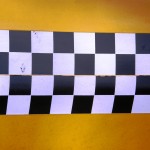I pass a London taxi drivers’ school every time I walk back from the office. It’s a stuff of legends (see below for concrete reasons), but until now, I had no idea how helpful their experience could be to future polyglots. Is there anything you can learn from taxi drivers to help your foreign language study? I think there is.
1. The Knowledge – a monster that changes your brain
It’s not easy to drive around London. Believe me, it’s not nice either. Most Londoners will only drive when they need to, and even then probably rely on sat-nav or stick to a handful of learned routes.
So imagine what it takes to know – not find, not google – but know – instantly where to go after being told the destination by your client. It takes a brain which is fed a special kind of information. In London, it’s called The Knowledge.
It’s a beast, and many people fail it numerous times before passing the test and becoming a qualified cabbie. It also does things to your head – studies have shown that your hippocampus actually grows as a result of learning The Knowledge. It’s hard to say whether more brain necessarily translates to a better life – but the effect is undeniable.
If this sounds daunting, consider learning a language. A few thousand words and phrases, a few dozen rules (and exceptions), alphabet, usage, collocations…the amount of stuff that needs to fit into an average language learner’s mind is just as impressive. How, then, does anyone actually succeed? And more importantly – how does anyone end up using these things at all?
2. The Run – a perfect blend of theory and practice
It turns out that there are more and less popular places in London. And there are more and less frequented routes. For a future cab driver, this is a godsend – you no longer need to compute your route from the several thousand possible streets. You take the easiest, most comfortable way – the fastest route from where you are to where the client wants to be. It sounds obvious, but only in theory 🙂 This is called a Run – the most practical way between two points, or the pre-memorized route between two points of interest. For example, most taxi drivers will know the way from any train station to any other train station by heart – and they should also know the order in which they’ll be passing theatres on the West End.
The Run is where theory meets practice. It makes sense to learn the most useful things first – and it’s the users who decide what these are. If, in a year’s time, everyone starts taking taxis to flower markets, then all London’s flower markets will become connected into Runs.
Language learners should know this already, and will sense what’s coming: there are Runs in the language you want to learn. Identify and learn them first. These will come without thinking to most native speakers – it will save you brain space if you take time to learn them almost instinctively as well. And crucially – remember these are likely to change. Your business Spanish will become useless during a tapas-and-sangria night out with friends – have your routes for different occasions!
3. The Appearance – and learning by doing
The test is called “the Appearance.” You’re told two points, and are supposed to recite precisely every turn, every street, every traffic light and point of interest appearing alongside the route. It’s funny to think of this and to remember the name: it’s almost as if it’s not the cabbie wannabe that puts in the appearance – but the route appears in front of her eyes.
How do you learn this? There are two ways. In the Knowledge school I pass most days, some people are sat around desks, eyes shut, fists with white knuckles pressed against their forehead – they’re having a mock “Appearance,” spouting out streets, turns, traffic signals and alternatives. This is preparing for the real thing, and with some pretty real pressure.
But there are others, and they are usually arriving or leaving from the yard in front of the school: each person on a scooter with a clipboard, weaving in and out of traffic, annotating their maps and cheatsheets, looking around for signs, detours, parking. How else can you learn this? How else would you ever find the confidence to drive other people around this monster of a city?
And, since this is a language learning blog: how else could you actually learn a foreign language? It’s OK to feel the stress of being tested – to fail, to cram, to sit and experience the pressure of vocab and grammar boiling in your head. But after all this drama, becoming an actual user of the language must feel almost like a relief – just as it feels for many of those Knowledge aficionados, who smile wearily as they finally get to sit on a scooter and make another piece of the puzzle come together.
4. Other Unlikely Polyglot Models – tell us yours?
I bet there’s someone who does amazing things around you. Someone who could change the way we look at our language learning. Let us know in the comments.
And tip your cabbie.
Wiktor (Vic) Kostrzewski (MA, DELTA) is an author, translator, editor and project manage based in London. When he works, he thinks about languages, education, books, EdTech and teachers. When he doesn’t work, he probably trains for his next triathlon or drinks his next coffee.
BRAVE Learning (formerly known as 16 Kinds) is a lifelong learning and productivity blog. If you enjoy these posts, please check out one of my books and courses.
My recent publications, and my archive, is now all available on my new project: PUNK LEARNING. Hope to see you there!


